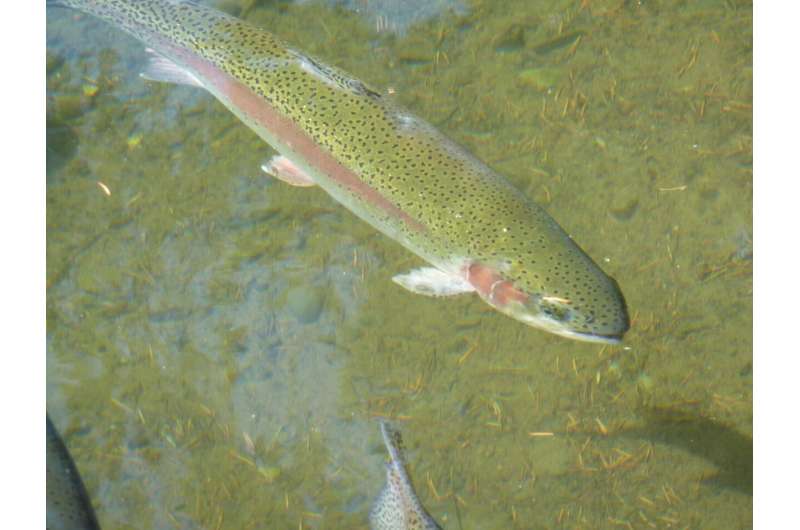This article has been reviewed according to Science X's editorial process and policies. Editors have highlighted the following attributes while ensuring the content's credibility:
fact-checked
peer-reviewed publication
trusted source
proofread
Thermal refuges help trout beat the heat in hot weather

What do fish do when the water gets too hot?
As climate change is making heat waves more common around the world, including here in Connecticut, understanding this question is becoming more important.
Cold-water fish like trout have a strategy for surviving extreme heat—moving into thermal refuges. Thermal refuges are areas in a river where colder water discharges into warmer stream water, creating a "cold-water patch." This can be caused by groundwater seeping into the stream at certain locations or even when a smaller, well-shaded stream joins a larger river, creating a plume of colder water.
Jason Vokoun, professor and head of the Department of Natural Resources and the Environment in the College of Agriculture, Health and Natural Resources, and Ph.D. student Christopher Sullivan are studying trout in thermal refuges along the Housatonic River to better understand this phenomenon.
Their recent findings were published in Ecosphere and found that not all thermal refuges are equal.
"What's really interesting about thermal refuges is that, as of several years ago, people conceptualized them as just these cold-water areas," Sullivan says. "But what we're finding out is their configuration and other attributes, in addition to long-term weather patterns, tend to be important determinants for how fish (and how many) use them."
The ideal thermal refuge is large, deep, and has a significantly lower temperature than the surrounding water. Using underwater cameras, the researchers observed that these refuges had the highest abundance of fish during a summer heat wave in 2022.
During the heat wave, mainstem river temperatures reached 30 degrees Celsius (or 86 degrees Fahrenheit) during the day. Trout comfortably tolerate water temperatures up to 17 degrees Celsius, or 63 degrees Fahrenheit, but must use thermal refuges as temperatures exceed 23–24 degrees Celsius, or 73–75 degrees Fahrenheit.
The refuges were, on average, one to three degrees Celsius cooler than the surrounding river water, ranging from half a degree to six degrees Fahrenheit cooler. The refuges' surface areas ranged from rather small to large (11 to 352 meters squared).
The researchers also found that the river gradient, how much the water surface elevation drops within the mainstem river near the thermal refuge, mattered too. A higher gradient river creates more turbulent waters, which are perhaps less appealing to heat-stressed trout.
The study found that fish abundance within the thermal refuges fluctuated extensively during the heat wave, suggesting that fish were leaving the refuge often. Given that thermal refuges tend to have very little prey for trout, Sullivan explains they could be leaving to get food in the mainstem river.
"It supports the hypothesis that fish can and will leave the refuge despite mainstem temperatures being inhospitable," Sullivan says. "The refuges are likely necessary for survival, but fish may not be trapped there as much as one might initially think. But over time with the changing climate, the proverbial noose might tighten."
In another study published in Ecology and Evolution, the team looked at terrestrial predators visiting and feeding in the refuges, which also impact how fish use the refuges.
Terrestrial predators observed included foxes, coyotes, bobcats, great blue herons, common mergansers, river otters, racoons, bald eagles, ospreys, as well as people fishing, kayaking, and visiting the refuges.
The researchers included humans as part of this list because, like other animals, we influence the ecosystems with which we interact.
In fact, there have been issues with illegal fishing in these refuges. And even those not fishing can impact these important areas. Fish will leave the refuge if they think there is a predator nearby. When people come to view the fish, the fish may interpret them as predators and flee the refuge, moving into warmer waters.
"People coming down and viewing this phenomenon of fish thermoregulating in refuges can have some indirect effects," Sullivan says. "My thought was by quantifying the rate at which people visit refuges, in addition to anglers, it can give an indication of the magnitude of these indirect effects."
Sullivan says he was surprised by how many people visited the refuge to observe the fish, a fact that can bolster future outreach and education programs.
"This is a well-known phenomenon that can be used as a tool for understanding the importance of fisheries management and habitat conservation," Sullivan says.
At times, there are hundreds of fish gathered in the shallow water of the refuges, making them vulnerable to predation. Yet, the researchers observed very few instances of actual predation in the refuges. Of the 2,500 observations of terrestrial predators visiting the refuges, there were only 22 predation attempts.
"To me, that's the really interesting part of the study," Sullivan says. "There were some instances of [predation]. But far fewer than we anticipated."
Sullivan says that while not as many fish are being eaten as they anticipated, the consequences of having to leave the refuge frequently to avoid being eaten may be great.
These studies support the need to protect these refuges and conduct research on the efficacy of protective strategies.
"We have known for some time that the thermal refuges are important to trout survival in several watersheds in Connecticut, but this project is helping the fisheries community, managers and anglers alike, focus on understanding how to conserve this limited thermal habitat for trout in our warming rivers," Vokoun says.
More information: Christopher J. Sullivan et al, Camera traps reveal that terrestrial predators are pervasive at riverscape cold‐water thermal refuges, Ecology and Evolution (2023). DOI: 10.1002/ece3.10316
Journal information: Ecology and Evolution , Ecosphere
Provided by University of Connecticut



















